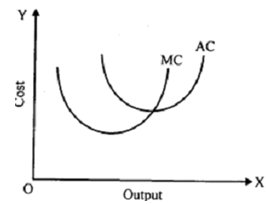Q. Relation between average cost and marginal cost?
Relationship between MC and AC are the following:
- If MC is below AC then AC should be falling. This is because, if MC is below AC then last unit produced costs less than AC of all the earlier units produced. If last unit costs less than earlier ones, then new AC should be less than old AC. So AC should be falling.
- If MC is above AC then cost of the last unit produced will be higher than AC of the earlier units. Henceforth the new AC should be higher than old AC. So when MC is above AC, AC should be rising.
- If MC is equal to AC, last unit costs exactly the same as AC of all earlier units. Therefore the new AC is equal to old AC. So the AC curve is flat when AC equals MC. Above mentioned relationship between MC and AC can be seen clearly with the help of figure below.

Figure: Relation between AC and MC
To the left of lowest point of the AC curve, MC is below AC so AC curve is falling. Even if MC is rising, AC would continue to fall as long as rising MC is less than AC. To the right of minimum point of the AC curve, MC is above AC so AC curve is rising. At the point where MC equals AC, AC curve is flat. Therefore the rising MC curve cuts AC curve at its lowest point.
Relationship between MC and AC can be easily understood by an illustration of a cricket player's batting averages. Let's presume that a cricket player's batting average is 40.
If in his next innings, he scores less than 40, let's suppose 30, then his average score would fall since his marginal score is less than his average score. In its place, if he scores more than 40, say 50, in his following innings, then his average score would increase since his marginal score is greater than his previous average score. Conversely, supposing the average score is 40, if batsman scores 40 in his subsequent innings then his average score would remain the same and his average and marginal scores will be equal.